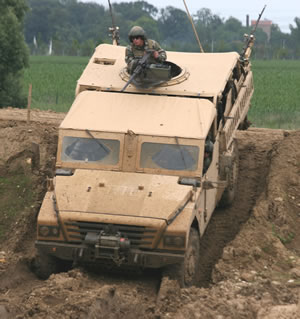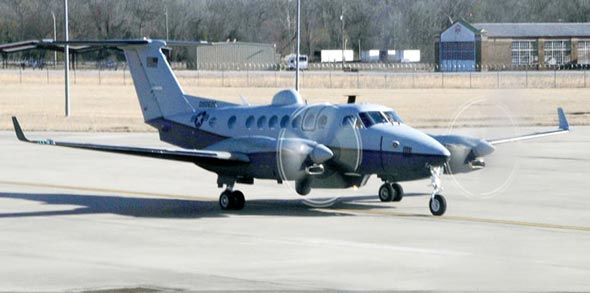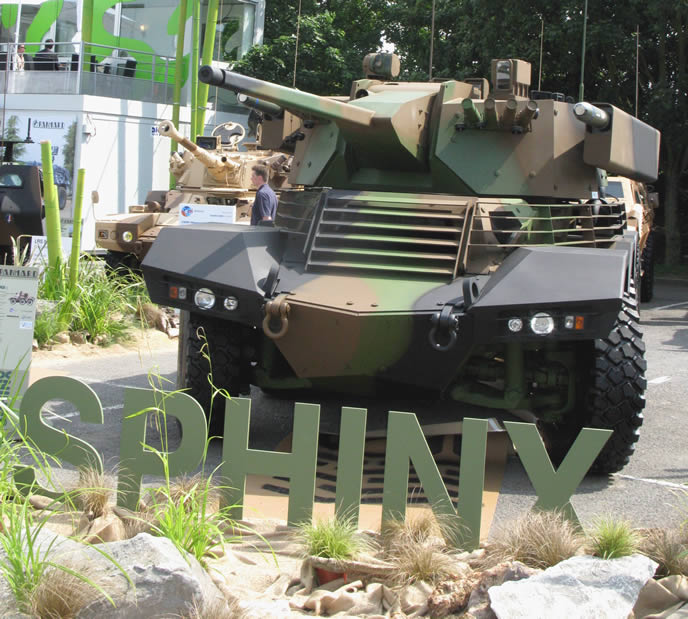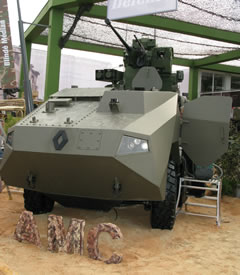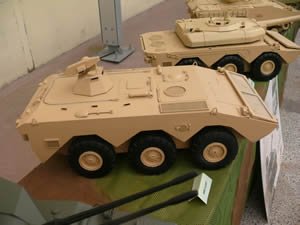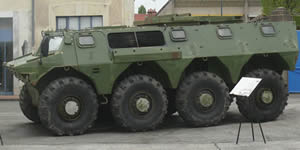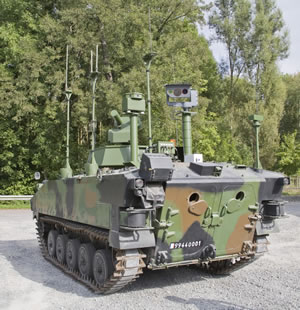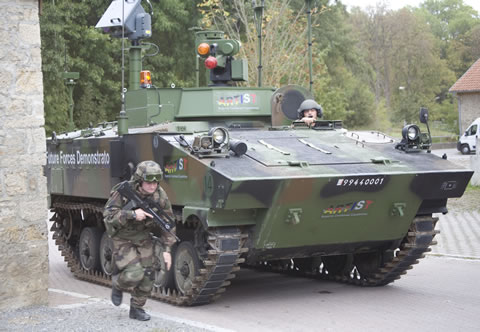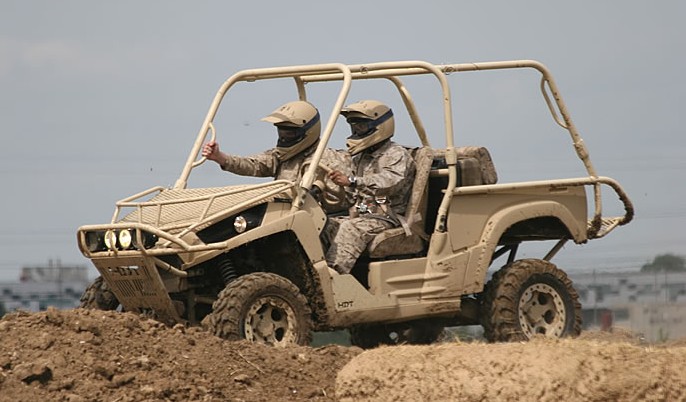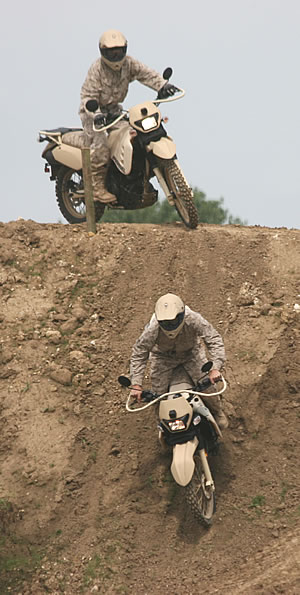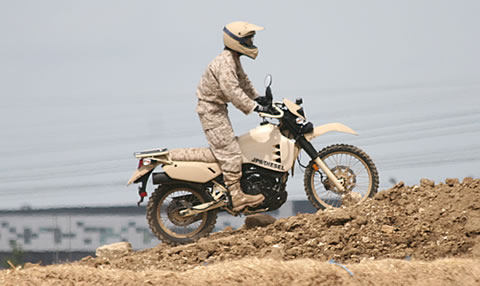Armored fighting vehicles and vehicle protection technologies were among the main highlights of the recent Eurosatory 2010 defense exhibition held in Paris, June 14-18, 2010. Many new vehicles were displayed, including new wheeled 8×8 fighting vehicles, heavy, medium and light mine protected vehicles, and, for the first time in many years, new tracked vehicles addressing the growing demand for armored mobility in the battlefield.
Two types of the Leopard 2, and Merkava 4 Main Battle Tanks (MBT) were shown here for the first time, along with a Leclerc tank displayed by Nexter. The growing interest the German Leopard 2 tank generates is due to its growing international presence, following the deliveries of surplus Dutch and German Leopard 2 A4 tanks to countries like Canada, Singapore and Chile. With these arms transfers, the Leopard became one of the most widely deployed tank, and a popular candidate for upgrading programs, such as the ‘Leopard Revolution’ modernization plan Rheinmetall Defense unveiled at Eurosatory. Krauss Maffei Wegmann (KMW) displayed the latest Leopard 2A7 model being proposed in support of the German forces in Afghanistan.
Back on the Tracks
Unlike the Multi-Purpose Vehicle (MPV) and other armored infantry carrier vehicles, maximizing protection ‘regardless of the consequences’, the designs of Main Battle Tank (MBT) and Infantry Combat Vehicle (ICV) are usually more balanced. While maintaining platform mobility in firepower and protection, key elements in these programs are the introduction of advanced armor solutions, protecting the vehicle against advanced IEDs and RPG, primarily in the rear section, engine compartment and suspension system. Other common elements are the introduction of protected, remote weapon stations fitted with high elevation coverage, and enhanced vision blocks, improving the commander’s visibility in urban terrain and close combat. Panoramic vision and 360 degrees engagement capability have become imperative. The Introduction of active defense systems, integrating soft and hard kill, have enhanced crew survivability. They include signature management solutions, advanced situational awareness sensors, millimeter-wave radars, electro-optical and close-in panoramic cameras and networked battle management systems which are providing the crew with situational understanding, effective coordination within a small unit and also as part of a larger combined arms formation.
Among the new tracked platforms at Eurosatory 2010 were the CV90 based Armadilo from BAE Systems, and updated versions of the Italian Dardo and Spanish-Austrian ASCOD from GDLS Europe. Krauss Maffei, SAIC and Boeing have discussed their plans to compete in the technology demonstration phase for the U.S. Army Ground Combat Vehicle (GCV). The team’s proposal is based on a new platform, in part on the technology developed for the German Puma armored infantry vehicle. The platform proposed by the U.S.-German team is expected to weigh around 65 tons, compared to Puma’s weight of 45 tons. If the team wins the program, the vehicles will be built in the U.S.A.
Boeing and SAIC were Lead System Integrators for the Army’s Future Combat Systems program, which included the development of the Manned Ground Vehicle (MGV), considered as the predecessor of the Ground Combat Vehicle (GCV). Another international candidate for the same program could be based on BAE systems’ CV90 Armadillo platform. BAE Systems together with General Dynamics Land Systems (GDLS) was the main subcontractor for the development of several types of these MGVs. Other designs, submitted by GDLS and Textron Systems have yet to be identified.
Eurosatory also provided the venue for launching of several upgrades on existing vehicles, including the Italian Dardo, equipped with unmanned 30mm HITFIST turret, modular counter-RPG protection and mine protection under the hull. The ASCOD was displayed mounting the 30mm Remotely Controlled Weapon Station, developed by Elbit System.
Wheeled AFVs become Heavier
Facing the latest threats from large roadside IEDs, shaped charge mines and IEDs and advanced RPGs, warfighters demand higher level of protection, but without compromising on mobility. These requirements lead manufacturers toward larger 8×8 wheeled vehicles and even heavier tracked vehicles, offering off-road mobility and high level of protection. Representing this trend are the latest 8×8 platforms including the Patria’s AMV, and heavier versions of the Piranha from General Dynamics Land Systems’, specifically the LAV II+, LAV III and recently unveiled Piranha Class 5. The Italian SuperAv and Centauro family of AFVs from Iveco are also representing this trend. In France, future 6×6 and 8×8 designs, proposed for the Scorpion program are offering higher protection and improved mobility. BAE Systems has also unveiled a new, mine-protected 8×8 vehicle – the RG-41. Positioned to support the military requirement for even heavier armored vehicles, several manufacturers are returning to tracked armored vehicles offering better off-road mobility, yet at a price in more extensive wear of road infrastructure.
Back to the wheeled vehicles, Nexter unveiled a new ‘VBCI on steroids’, fitted with enhanced protection, utilizing the more modules available with the SafePRO armor concept. This VBCI featured new side armor, enhancing protection against IEDs and RPGs, combining reactive and passive modules with SlatAlu ‘cage’ armor. While this enhanced protection VBCI demonstrates how a future vehicle could look like, the current VBCIs destined to reach Afghanistan later in the summer of 2010 are still being equipped with the SafePro counter-RPG net from RUAG. This net will enhance the vehicle’s protection against such weapons, which are considered second only to IEDs.
Mine Protected Vehicles
he now established Mine Resistant Ambush Protected (MRAP) category also known as ‘Mine Protected Vehicles’ (MPV) is also expanding to offer better off-road mobility, with the introduction of independent suspensions axles or other systems better adapted for off-road mobility. The growing demand for such a vehicle is opening new markets for specialty chassis producers. In addition to the heavy MRAPs, like the U.S.-made MaxxPro and M-ATV, Renault has introduced its own MRAP MPV, based on the Sherpa truck.
In the light-weight category, several new vehicles were introduced here, including two new versions of the Aravis from Nexter and a new recovery vehicle, based on the KMW Dingo II. Among the new category of lighter vehicles recently introduced to the market were the Hawekie, developed by Thales. This vehicle is currently competing against two other international manufacturers on a large Australian order. A similar vehicle is the German AMPV, developed by a consortium of KMW and Rheinmetall Defence. The Swiss Eagle IV is also designed for the light armored protected vehicle segment, designed for a maximum gross weight of 10 tons. Two other protected vehicles in this category shown at Eurosatory, are the Ocelot from Force Protection and SPV-400 from Supacat. Both are contenders for the Australian program, as well as for the British Light Protected Patrol Vehicle (LPPV) program.
Mine Protected Vehicles are also adding weight, due to the enhancement of their armor suite. Based on a chassis produced for specialty vehicle, these vehicles are often limited in their mission-payload carrying capability, much of the available capacity being dedicated for the additional armor, all-terrain mobility kits and other mission equipment. Therefore, the requirement for heavier platforms, prepared from baseline, for off-road mobility is becoming evident.
At Eurosatory, several companies have introduced such chassis designs, including Mercedes Benz military trucks (offering new Unimog and G-9 platforms) and novel platforms offered by the Oshkosh-Tatra JV. When more compact vehicles are considered, manufacturers may opt for designs that dispense with the chassis entirely – among these is Israel’s Hatehof, introducing its Xtream vehicle. However, when low cost and high protection are both imperative requirements, manufacturers tend to favor commercial chassis. Few examples from recent Eurosatory displays were, the MDT Armor Tiger light protected vehicle, utilizing the Dodge RAM 5000 and Zeev, employing the Ford 550 displayed by Hatehof; The Kombat VIP armored car utilizing the GMC Sierra or Chevrolet Silverado was displayed by the St. Petersburg based Russian Combat Armoring Group. Another Israeli vehicle – the Musketeer from Saymar, was also displayed for the first time, based on the Toyota Land-Cruiser. Commercial off-the-shelf components and subsystems are also imperative in making vehicle serviceable in-theater without having to deliver the entire supply chain, through highly vulnerable logistical support lines.
Another important factor is the user’s ability in maintaining the life-cycle management of the protected cabs only, rather than the entire vehicle. In most cases, the protected capsule is separated from the chassis, and can therefore match with a new chassis once the original one wears out.



